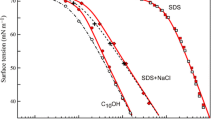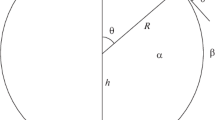Abstract
The measurement of surface and interfacial tension from the maximum pressure in sessile and pendant bubble and drops is, described. New theoretical data are presented which enable the surface and interfacial tension to be calculated without iteration.
Although the maximum pressure in pendant bubbles is less than that in sessile bubbles, they retain their symmetry during detachment from the capillary tip and so havt experimental advantages. Reproducible results in good agreement with literature values are obtained for the surface and interfacial tension of several liquids and immiscible liquid pairs.
Similar content being viewed by others
Abbreviations
- b:
-
radius of curvature at apex of sessile or pendant interface
- B = bc1/2 :
-
dimensionlessb
- c = (ρh − ρ1) g/σ:
-
constant characterizing physical properties
- g:
-
acceleration due to gravity
- ha :
-
height of upper surface of manometric fluid below free surface of liquid
- hm :
-
manometric head
- ht :
-
length of tube immersed in heavy liquid
- Δh :
-
equivalent net hydrostatic head
- Ah max :
-
maximum value of Δh
- ΔH= (Δh)c 1/2 :
-
dimensionless Δh
- ΔH max :
-
maximum value of ΔhH
- m:
-
constant in the expression for temperature coefficient of surface tension
- n:
-
constant in the expression for temperature coefficient of surface tension
- Δp :
-
excess pressure at apex of sessile or pendant drop
- r:
-
radius of capillary tube
- X = rc 1/2 :
-
dimensionless radius
- z:
-
vertical distance from apex of sessile or pendant interface
- Z:
-
dimensionlessz
- θ:
-
temperature
- ρa:
-
density of air
- ρh:
-
density of heavy fluid
- ρ1 :
-
density of light fluid
- ρm:
-
density of manometric fluid
- σ:
-
surface or interfacial tension
- σ0 :
-
surface tension at 0° C
References
Simon, M.,Ann. Chim. Phys. 32 5(1851).
Jaeger, G., Sitzungsler,Akad. Wiss. Wien. 100 IIA 265, 493 (1891).
Sugden, S.,J. Chem. Soc. Trans. 121 858 (1922).
Rose, W. E. and Seyer, W. F.,J. Phys. Coll. Chem. 55 439 (1951).
Hartland, S. and Hartley, R. W.,Axisymmetric Fluid-liquid Interfaces, Elsevier, Amsterdam (1976).
Ferguson, A.,Phil. Mag. Ser. 6.31 37 (1916).
Richards, T. W., Speyers, C. L. and Carver, E. K.,J. Amer. Chem. Soc. 46 1196 (1924).
International Critical Tables. Vol. IV, McGraw-Hill Book Co. Inc., N. York (1928).
Jasper, J. J. and Kring, E. V.,J. Phys. Chem. 59 1019 (1955).
Padday, J. F. and Uffindell, N. D.,J. Phys. Chem. 72 1407 (1968).
Harkins, W. D., Clark, G. L. and Roberts, L. E.,J. Am. Chem. Soc. 42 700 (1920).
Author information
Authors and Affiliations
Rights and permissions
About this article
Cite this article
Ramakrishnan, S., Mailliet, K. & Hartland, S. Measurement of surface and interfacial tension from the maximum pressure in sessile and pendant bubbles and drops. Proc. Indian Acad. Sci. 83, 107–118 (1976). https://doi.org/10.1007/BF03051197
Received:
Issue Date:
DOI: https://doi.org/10.1007/BF03051197




